Here, we document some of the extant pieces up to the end of the 16th/early 17th C. We stop here, as shoes and boots
from the 17th to 18th are fairly well documented in other works, and we have a great many more extant pieces from those
periods.
One of the tallest chopines in existence. These chopines are approximately 20" high, and would be quite a challenge to walk in, even with helpers. Elizabeth Bernhardt provided the picture of these, and I'm indebted to her for the reference.
Twenty-inch Chopines, 16th century
c. 1600
Museo Correr dei Veneziani
|

|
Another set of enormously large chopines. The surround and vamp is in much better shape than the chopines in the Museo Correr dei Veneziani above, and the vamp actually extends a bit, similar to the ones above. Although I could not find the link any longer that connects to it, these pictures were obtained from www.marquise.de.
Split, damaged white chopine
c. 1600
Museum Weissenfels, Germany
|
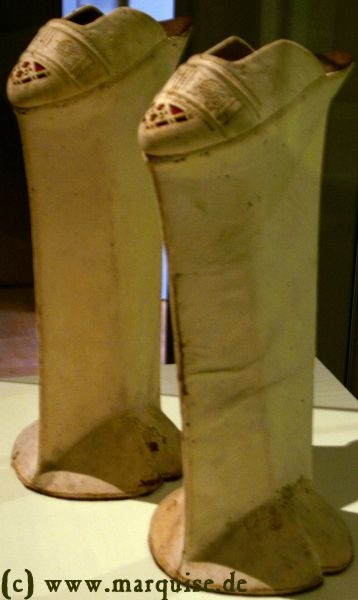
|
This chopine is clasified as "calcagnini" by Semmelhack. The grooves in the bottom of the pedestal are likely created by running a shoemaker's stitch along the inside of the surround, but poking through to the outside for a brief amount to pull the sides together.
White chopine
c. 1590 - 1600
Museo Stefano Bardini, Florence, Italy
|

|
One of the many pairs of chopines located at the MFA. I strongly suggest you search through their collection looking for "chopine" or "chopines" and you will find a number of photographs. This pieces is a wooden base with a leather surround, with some tassels and braiding up and down the seams. The vamp is tooled and split, although it seems to be only a single row of holes.
Woman's pianelle (or chopines)
1590–1610
Museum of Fine Arts, Boston
|
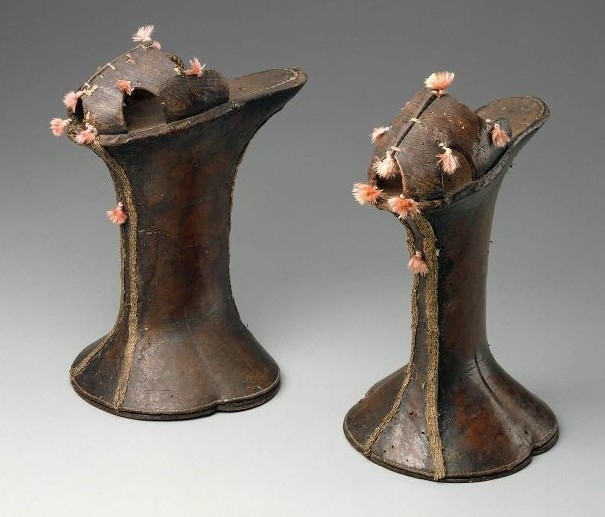
|
Covered with white kid and measuring about seven inches high, these have a small little punched pattern in the center. It's unclear to me if the two rows of vertical marks are stitch holes, or just ornamentation. My supposition is ornamentation, since the stitching at the bottom and glue should have been sufficient to keep the leather on.
Pair of Chopines
c. 1600
Victoria and Albert Museum, London
|

|
A pair similar to those in the MFA, these are located at the Stibbert museum in Florece, Italy. Notice again the very wide base, likely to ensure longer survival of the wearer. (Thanks, Mari!)
Pair of Chopines
c. 1600
Museo Stibbert, Florence
|

|
A chopine with a wooden base, covered with leather, and tufts on the vamp. Again, I strongly suggest you visit the MFA website to look at all of the chopines that they have in their collection.
Chopine
17th Century
Museum of Fine Arts, Boston
|

|
An extant Spanish chopine, clearly showing the use of the second row of holes in order to tie a split vamp together. The seam on the front is also visible, and the sole seems abnormally thick, or perhaps covered with some other material. Very coarse whip stitching can be observed on the front of the vamp.
Chopine of Tooled Leather
ca. 1550
Barcelona, Museo de Indumentaria
B&W Scan from Anderson
|
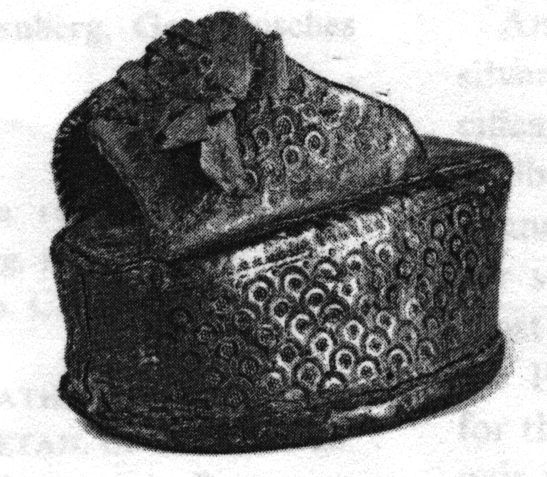
|
An extant Spanish chopine, again showing the second row of holes (on both sides) in order to tie a split vamp together. Although the current lace is only laced through the first set, the pictorial evidence clearly shows an alternate lacing. One chopine still has a metal band around the bottom, and the other shows evidence of where a band once was. This is a color photograph of the piece that Anderson has examined in her work (232, Figs 546-548).
Chopines of Tooled Leather, One Banded with Lead
ca. 1550
Solsona, Museo Diocesano
|
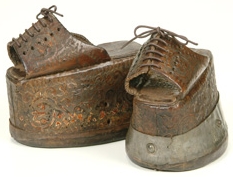
|
A chopine, covered in velvet, with the characteristic double holes used in the Spanish models. Note some rough stitching on the vamp and the stitching keeping the sole onto the surround. In Moda, we are told that most of the slippers recorded in seem to be covered in fabric, more specifically velvet, except for one pair in aquaramarine satin (143).
Velvet Covered Chopines
16th Century
Bata Shoe Museum, Toronto, Canada
Color Scan from O'keefe
|

|
A chopine in the Italian style, from the Bata Shoe museum. This particular piece is covered with velvet, metal studs, and gilt and silver lace and braid, a truly excellent piece.
Velvet-covered Chopines
1580 - 1620
Bata Shoe Museum, Toronto, Canada
|
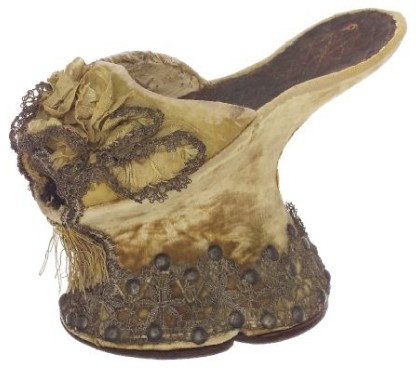
|
This piece seems to be covered with a voided velvet. Note that these have the same kind of double holes that the Spanish styles often incorporate, proving that Italian chopines also used this same kind of closure. Again, I've left the scan full size for you to examine the detail.
Brocade Covered Slippers (chopines)
1565 - 1600
Museo Bardini, Florence
Color Scan from Moda
|
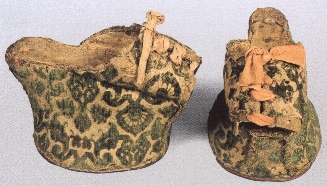
|
Another chopine, also covered in velvet, with edging around the split vamp and the front and possibly back. Sole stitching is visible through the velvet. It is possible that because the insole of this chopine is covered in velvet, that it was intended for indoor use (Semmelhack).
Velvet Covered Chopines
16th Century
Bata Shoe Museum, Toronto, Canada
Color Scan from O'keefe
|
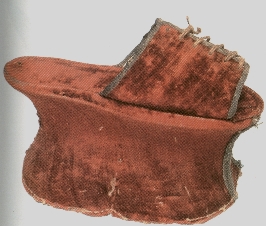
|
A chopine, covered in embroidered velvet, with an open toe and a slightly differently shaped vamp than many we have shown here. We are told that there is a satin sock along with this piece as well. Additionally, there is no stitching that can be seen attaching the sole to the chopine itself. The sole could possibly have been glued or nailed on.
Velvet Covered Chopines
c. 1600
Ashmolean Museum, London, England
B&W Scan from Arnold
|
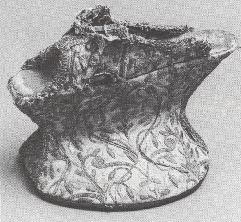
|
A lovely white chopine, this one flat fronted with an ornamented vamp, and ribbons
tied through the holes. Likely, there were others, but these are not present. This particular piece was the inspiration for an amazing Swiss reproduction (see the Reproductions page).
White Leather Chopines
c. 1600
Bally Shoe Museum, Schonenwerd, Switzerland
Color Scan from O'Keefe
|
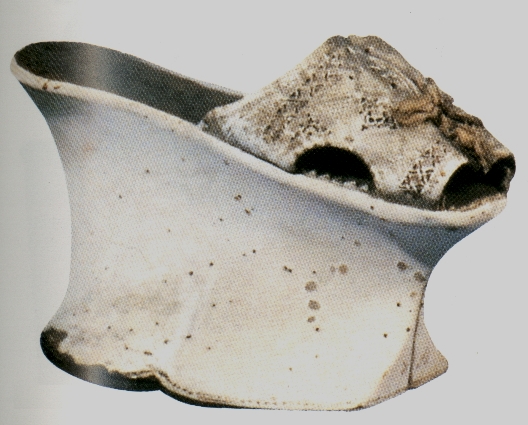
|
This pair is also located at the Stibbert museum in Florece, Italy. Velvet covered, ruched ribbon on the front, metallic braid and lace around the piece.
Pair of Chopines
c. 1620
Museo Stibbert, Florence
|
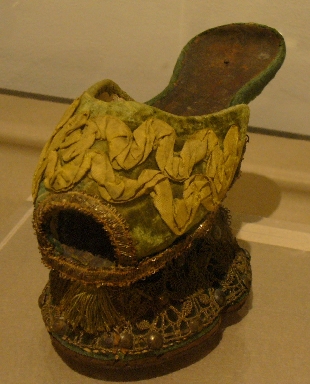
|
This salmon covered chopine is dated by the MFA to the late 17th - early 18th, and is almost a replica of the goldenrod covered piece currently in the Bata. It is also similar to the blue velvet covered piece in the (now closed) Brooklyn Museum. After a personal conversation with the curator of the Bata Shoe Museum, it seems that this dating is the result of some confusion, and is likely a piece dating to the early 17th century.
Woman's Pianella
Early 17th Century
Museum of Fine Arts, Boston, United States
|
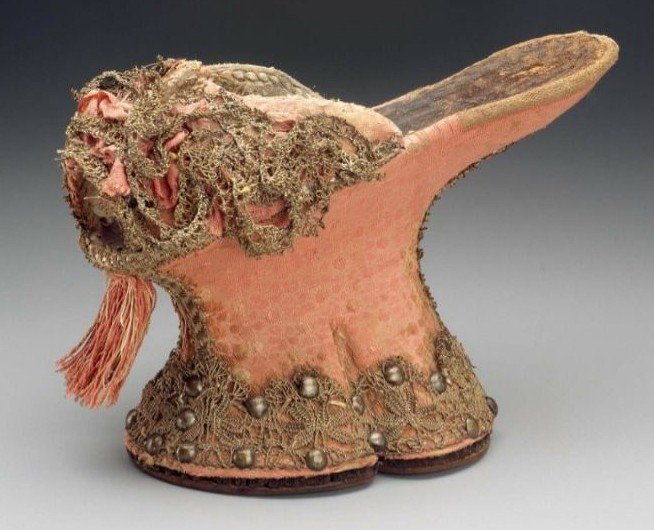
|
Again, this chopine is also dated to the 1740s by the MFA, but I believe this to be in error. A pair like this are classified by Semmelhack as "zibroni," but this term does not appear in Florio's dictionary, so it may be a more modern term for this type of pianella.
Pair of chopines
Early 17th Century
Museum of Fine Arts, Boston, United States
|
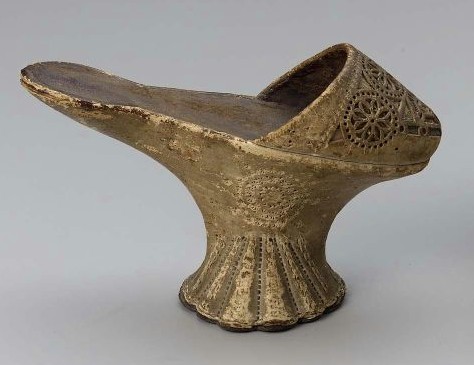
|
This particular piece is covered with beige (it may originally have been tawed white), with beautiful tooling and cutwork on the vamp and the surround.
Pair of Chopines
c. 1600
Metropolitan Museum of Art, New York, USA
|
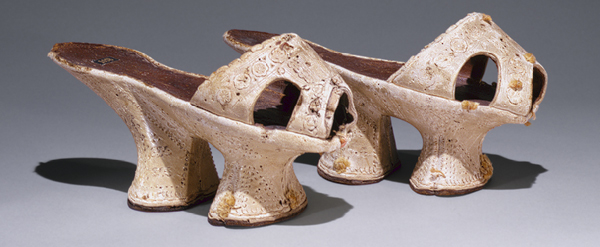
|
A piece similar to the pair from the Met, in this photograph, one can see the stitching through the surround.
White Chopine
c. 1600
Museum Weissenfels, Germany
|
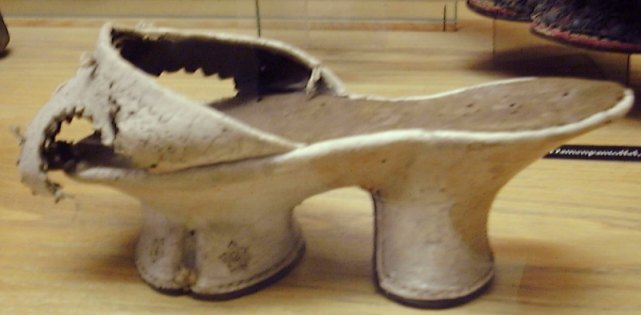
|
A lovely pair of what were once white chopines, with ornate cutwork showing a red underlayer, similar to the painting of Cleopatra by Bordone. I've left this full size so you can see the detail in the piece.
Leather Covered Slippers (chopines)
1550 - 1575
Museo Bardini, Florence
Color Scan from Moda
|
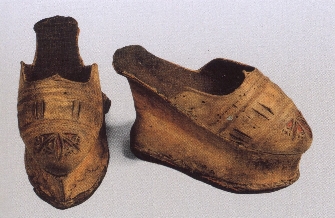
|
A pair of shorter chopines, made of wood and velvet, leather and silver gilt braid and bobbin lace.
Pair of Chopines
c. 1600
Victoria and Albert Museum, London
|
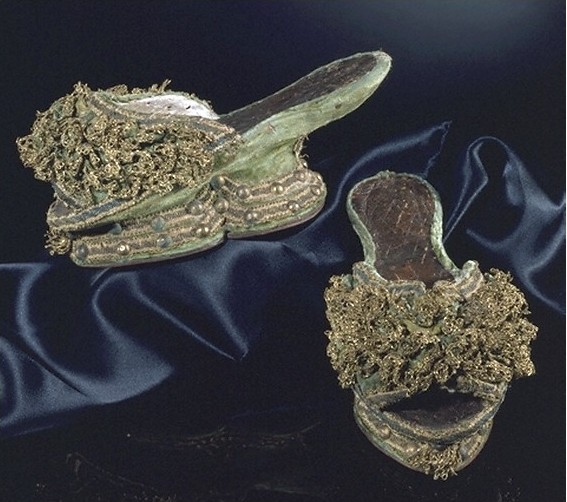
|
A pair of arched buskins. They are likely cork based, finished in brown suede.
Brown Leather Buskins
c. 1600
Ashmolean Museum, Oxford, England
B&W Scan from Arnold.
|
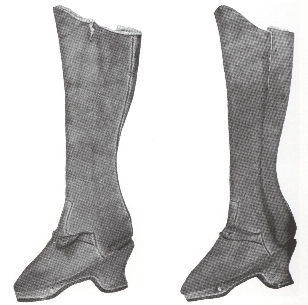
|
A pair of arched heeled shoes. These are alum tawed with a suede finish, and one can
observe the stitching on the heel as well as the tunnel stitches catching the top down.
White Shoe
c. 1600
Ashmolean Museum, Oxford, England
Picture from the Ashmolean Museum.
|

|























